Tamping is the method to properly level the surface of coffee grounds on the portafilter so that all the coffee grounds get extracted completely and evenly.
Tamping the Coffee grounds in the portafilter is an art. You should master that art if you want the best from your shot of Espresso.
Key Takeaways
- Distribute grounds evenly before tamping by rotating the portafilter as you fill it.
- Use a flat, even surface for tamping rather than holding the portafilter in your hands.
- Apply light pressure, just enough to fill air pockets, not maximum force.
- 20-30 lbs of force is a myth – pressure just needs to compact the grounds.
If you own the best espresso machine and have bought the best Espresso Coffee Beans, your grind setting is also perfect. But all these things are in vain if you don’t know the right tamping technique!
Many questions might come into your mind, like how hard you should press the tamper. Or does the level of coffee grounds on the portafilter really matter? I will answer these questions and teach you how to tamp espresso evenly like a PRO!
How to tamp Espresso properly? A step-by-step Guide
Simply follow these five steps, and you will become a pro in tamping.
1. Fill the portafilter with grounds and level them
The first step is to fill the portafilter with the coffee grounds straight from your grinder.
Revolve your portafilter in a circle while filling to distribute the coffee grounds evenly in the portafilter.
If you don’t revolve it, a pile of coffee grounds will build up at the center, and there will be fewer coffee grounds at the sides.
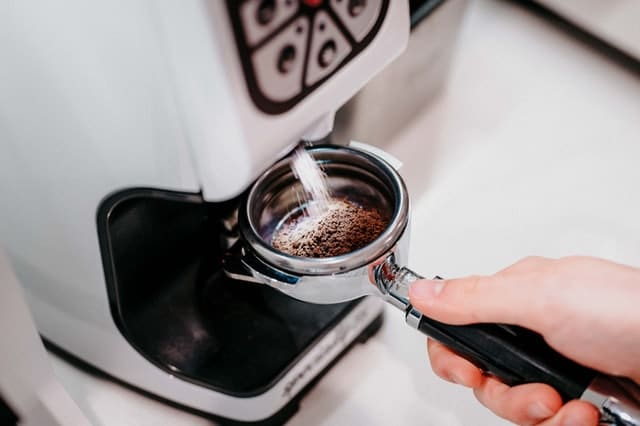
The surface of coffee grounds should be even before tamping. You can use a distribution tool if you want to achieve perfection. The distribution tool will distribute the grounds super evenly in the basket before you tamp.
Or you can simply level them with your fingers if you don’t want to invest in a distribution tool. The distribution tool doesn’t make that much difference. Don’t buy it if you are not a perfectionist like me.
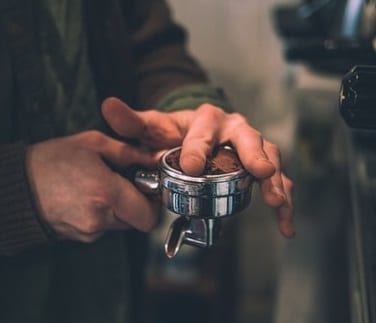
Using the right type of Portafilter basket is also very important. Read a detailed guide on Espresso Portafilter Basket types to see why non-pressurized naked portafilters are best.
2. Place it on a flat surface
Place your portafilter filled with coffee grounds on a shelf in your kitchen, or any flat surface.
Don’t tamp the grounds while holding the portafilter in your hands, as it will make the surface uneven.
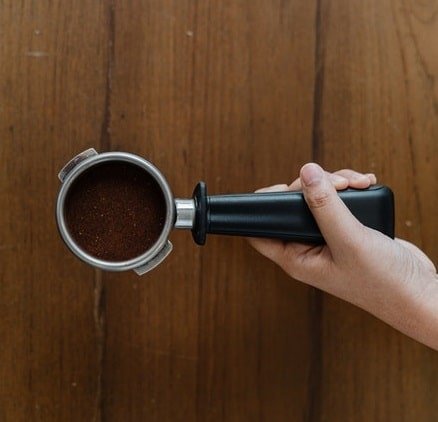
3. Hold the tamper like a pro and make an angle
Now hold the tamper in your hands just like you hold Mike, with your thumb and index finger at the edges of the portafilter.
Make sure that your biceps are parallel to the handle of the portafilter. And your arm should be perpendicular to the portafilter.
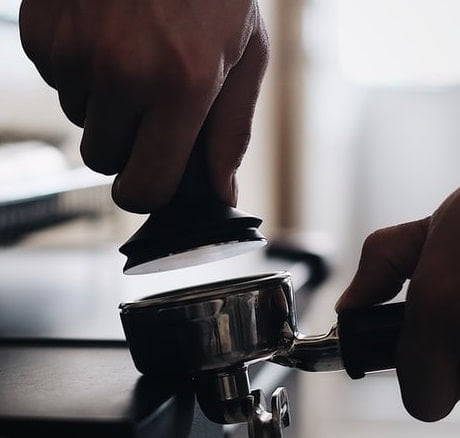
4. Apply force
Now apply some force to distribute the grounds evenly, and the empty spaces among them fill up.
But How Hard Should You to Tamp Espresso?
Apply just enough pressure that the coffee grounds push back at you and the grounds are spread in the portafilter nice and tight .
If you tamp espresso too hard as it can compress the coffee grounds into an overly dense puck. This creates too much resistance for water to flow through, and channeling can occur.
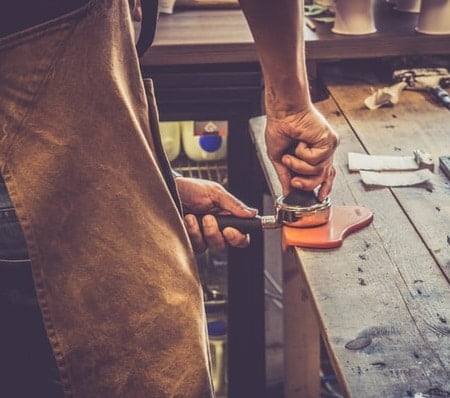
How much Pressure to Tamp Espresso?
You might have heard somewhere that 20 lb of force is necessary or 30 lb of force is necessary. But this is completely a myth!
The amount of force doesn’t make any difference as long as you are applying just enough force to fill in the empty air pockets.
How can one measure the force anyway while tamping anyways?
5. Inspect the puck and clean the edges of the portafilter
Before putting the portafilter into the espresso machine, make sure that the puck is even and flat. Sometimes our angle gets titled, and the puck becomes uneven. In that case, discard the puck and repeat the process.
Clean off any coffee grounds that have spilled around the edges of the portafilter. This will help to protect the portafilter gasket and reduce espresso machine maintenance.
Also Read: Is Wet Espresso puck a problem
How to tamp Espresso without a tamper?
Ideally, it would be best if you had a tamper to pack your Espresso grounds correctly. But what if it’s lost or you don’t want to buy one?
Well, in that case, you can tamp the puck with any flat surface or round object present in your home. It can be an empty beer bottle, a shot glass, the back of a teaspoon, a pill bottle, or a small-sized can.
When tamping without a tamper, the first three steps mentioned above remain the same. And while applying force, you should be very careful as it can ruin the surface of your puck.
The first thing to keep in mind is that the size of the object you are using should exactly match your portafilter’s size. If the size of the object you are using is smaller, it will make the surface uneven and distorted, and if it’s larger, surely it will not fit into the filter, and you can not use it for tamping.
Read a guide on How to use a Espresso Machine
What are the different types of tampers?
There are different types of Espresso tampers available in the market.
The two main types of tampers are convex and flat. Convex, as the name suggests, has a slightly rounded surface. The main reason behind this somewhat spherical surface is to avoid side channeling from the sides of the basket.
The flat tampers have a completely flat surface, making the puck even and flat. I personally like flat tampers more than convex tampers.
Another tip for choosing a perfect tamper is to always select the tamper with a thick base as it allows you to tamp deeper.
What Happens if you don’t Tamp Espresso?
Tamping Espresso is necessary because If you don’t, the grounds will not get packed together tightly, and the pressurized water will pass through the place where there are the least coffee grounds, leaving all other coffee grounds unextracted.
This is called Espresso channeling. When channeling occurs, some grounds will get over-extracted while others remain under-extracted.
This will make your shot both bitter and sour at the same time, and the taste will be very uneven, just like the surface of the coffee grounds you left in the portafilter.
So how do you know Espresso channeling is going on?
Just visualize the drops coming out of your portafilter. If you see that the drops are coming faster from one side than the other, it’s a clear indication of Espresso channeling.
For Making a better shot of Espresso read a guide on Dialing in Espresso Machine
Final thoughts
This is not the only method to tamp Espresso. You might have heard of different tamping methods from Baristas or coffee experts. Some might recommend tamping at different angles, and some might recommend applying a large amount of force.
I have tested and applied different methods for tamping to brew espresso shots, and I have figured out the best way to pack Espresso grounds in the portafilter, which I have shared with you. I hope you will like that method too.
And always remember that the best brewing time for Espresso is 25 to 30 seconds; if your shot is taking less time than that, then this might be an indication of espresso channeling. You have to change your tamping technique in that case.
FAQs
How to make a good crema?
For the best crema, use fresh, high-quality coffee beans roasted medium to dark. Freshness allows CO2 and oils to remain intact during extraction. Grind beans finely, and tamp evenly as it allows pressurized water to extract oils properly.
Is it bad to tamp twice?
Yes, it is generally not recommended to tamp your espresso grounds twice. Tamping twice can over-compress the puck, which creates too much resistance for the brewing water to flow through properly.
Read Reviews of affordable Espresso Machines



